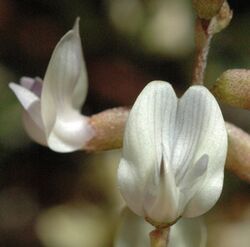Biology:Astragalus applegatei
| Applegate's milkvetch | |
|---|---|

| |
| Scientific classification | |
| Kingdom: | Plantae |
| Clade: | Tracheophytes |
| Clade: | Angiosperms |
| Clade: | Eudicots |
| Clade: | Rosids |
| Order: | Fabales |
| Family: | Fabaceae |
| Subfamily: | Faboideae |
| Genus: | Astragalus |
| Species: | A. applegatei
|
| Binomial name | |
| Astragalus applegatei M.Peck
| |
| Synonyms | |
| |
Astragalus applegatei is a rare species of milkvetch known by the common name Applegate's milkvetch.[2] Its scientific name is also spelt Astragalus applegatii.[3] It is endemic to Klamath County, Oregon, where it is known from three populations, one of which is made up of only three plants.[2] Much of the remaining habitat is seriously threatened by development, introduced plant species, and other forces.[2] This is a federally listed endangered species of the United States.
The plant is a perennial herb with clustered or spreading prostrate stems growing from a taproot. It may form mats nearly a metre wide and up to 40 cm tall. The leaves are up to 8 cm long and are each made up of several pairs of leaflets 1 or 2 cm long. The inflorescence is a raceme of nodding flowers. The flower has a cuplike, toothed calyx of sepals coated in black hairs. The corolla is whitish to lavender with purple tips on the petals. The fruit is a purple-mottled legume pod roughly 1 cm long.[4]
The native habitat of the plant is a seasonally wet floodplain with alkali soils, part of the Klamath Basin.[1]
The largest of the three populations is on land which is partially owned and protected by The Nature Conservancy, but the other part is vulnerable to development.[2] The second and third populations are very small and may not survive as they become inbred.[2] There was once a fourth population, but it was destroyed when its habitat was made into a grocery store and a car dealership.[2]
References
- ↑ 1.0 1.1 "The Nature Conservancy". http://www.natureserve.org/explorer/servlet/NatureServe?searchName=Astragalus+applegatei.
- ↑ 2.0 2.1 2.2 2.3 2.4 2.5 Center for Plant Conservation
- ↑ Peck, Morton E. (1936), "Six new plants from Oregon", Proceedings of the Biological Society of Washington 49: 109–112, https://www.biodiversitylibrary.org/page/34552401, retrieved 2023-04-03, p. 111
- ↑ "USDA Plants Database". https://plants.usda.gov/core/profile?symbol=ASAP.
External links
Wikidata ☰ {{{from}}} entry
 |


